Are you tired of dealing with excess shine, enlarged pores, and frequent breakouts? If you have oily skin, you know the struggle all too well. But fret not; we are here to help you master your skincare routine and achieve a balanced and radiant complexion. This article will explore expert beauty tips for oily skin and skincare routines specifically designed for women with oily skin.
Understanding the unique challenges of oily skin is the first step towards managing it effectively. From deciphering the causes of oily skin to debunking common misconceptions, we’ll delve into the world of oily skin care in detail. Identifying your skin type accurately is vital in determining the most suitable skincare routine.
A daily skincare routine tailored for oily skin is crucial in maintaining a clear and balanced complexion. We will guide you through the essential cleansing, toning, and moisturizing steps, highlighting the best practices for oily skin. Additionally, we’ll share valuable beauty tips specifically catered to oily skin, helping you enhance your natural beauty.
Exfoliation is vital in unclogging pores and removing dead skin cells, but it can be tricky for those with oily skin. We’ll guide you on how often to exfoliate to achieve optimal results without triggering excess oil production.
Choosing the right skincare products is vital to managing oily skin effectively. We’ll discuss the ingredients to look for in oily skin products and help you navigate labels like non-comedogenic, oil-free, and matte.
Additions like face masks and targeted treatments can help control excess oil and reduce acne breakouts. We’ll explore various options specifically designed for oily skin.
Finding the right products for oily skin can make all the difference in makeup. We’ll guide you in selecting primers, foundations, and setting techniques to combat oiliness and achieve a long-lasting, matte finish.
Additionally, we’ll provide sample skincare routines for oily skin, discuss natural remedies using homemade masks and scrubs, and explore the role of diet and lifestyle in managing oily skin’s impact. We’ll also shed light on when to consult a dermatologist for severe cases of oily skin.
Hormonal fluctuations can significantly affect oily skin, leading to hormonal acne. We’ll delve into how hormones impact oily skin and help you adapt your skincare routine to manage these changes effectively. Furthermore, we’ll introduce advanced beauty techniques and procedures tailored to oily skin.
Following the beauty tips and techniques discussed throughout this article, you can master your skincare routine for oily skin. Say goodbye to excess shine and hello to a balanced, glowy complexion that showcases your natural beauty.
Understanding Oily Skin and Its Challenges
Before diving into the world of oily skin care, it is essential to understand the causes of oily skin and debunk common misconceptions. Understanding the unique challenges those with oily skin face will help you develop an effective skincare routine tailored to your needs.
What Causes Oily Skin?
Oily skin occurs when the sebaceous glands produce excess sebum, the oily substance that helps moisturize and protect the skin. Several factors contribute to the overproduction of sebum, including:
- Genetics: Oily skin may be hereditary, meaning you are more likely to have oily skin if your parents also have it.
- Hormonal fluctuations: Hormonal changes during puberty, menstruation, pregnancy, and menopause can increase sebum production.
- Environmental factors: Humid weather, hot temperatures, and exposure to pollution can stimulate the skin to produce more oil.
- Incorrect skincare routine: Using harsh or drying products can strip the skin of natural oils, triggering the sebaceous glands to produce more sebum as a compensatory response.
Common Oily Skin Misconceptions
Several misconceptions surrounding oily skin can lead to ineffective or damaging skincare practices. Let’s debunk some of the most prevalent myths:
| Myth | Truth |
|---|---|
| Myth: Oily skin doesn’t need moisturizer. | Oily skin still needs hydration. Look for lightweight, oil-free moisturizers that provide adequate hydration without adding excess oil. |
| Myth: Washing your face frequently reduces oiliness. | Truth: Overwashing can strip the skin, triggering the sebaceous glands to produce even more oil. Stick to cleansing twice a day with a gentle cleanser. |
| Myth: Oily skin is dirty. | Truth: Oily skin is not a result of poor hygiene. It is a skin type determined by genetics and other factors beyond your control. |
| Myth: Using oil-based products worsens oily skin. | Truth: Not all oils are harmful to oily skin. Some lightweight, non-comedogenic oils can help regulate sebum production and balance the skin. |
Identifying Your Skin Type
Identifying your skin type accurately is the crucial first step in developing an effective skincare routine. Here’s a simple guide to determining your skin type:
- Wash your face with a gentle cleanser and pat it dry.
- Wait for about an hour without applying any products.
- Observe your skin in a well-lit area with a mirror.
- Pay attention to the presence or absence of shine, tightness, and the size of your pores.
- Based on your observations, determine your skin type as oily, dry, combination, or average.
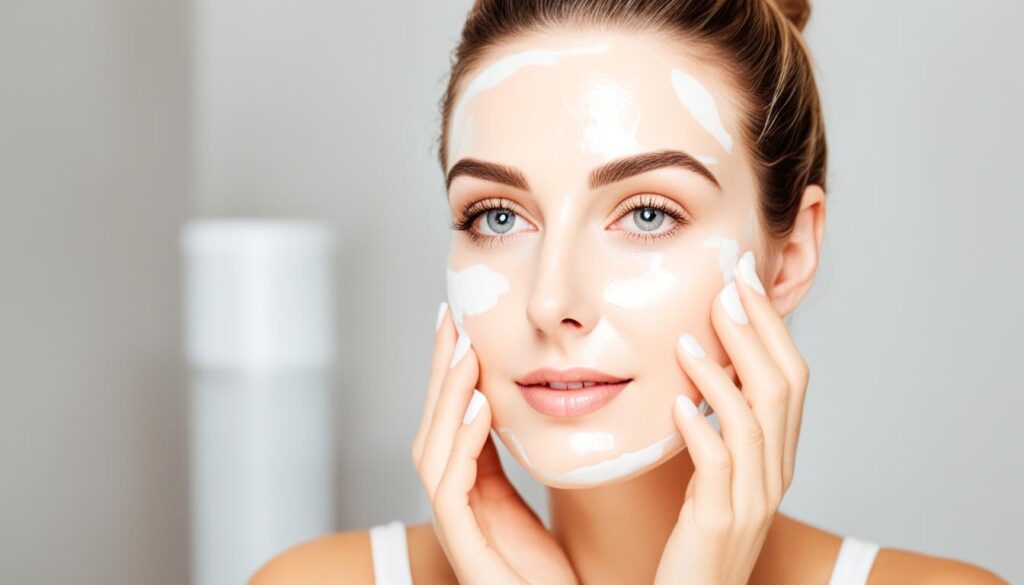
Daily Skincare Routine Steps for Oily Skin
Establishing a consistent daily skincare routine is crucial for managing oily skin. You can achieve precise and balanced skin by following a targeted and effective regimen. This section will explore the three essential steps of a daily skincare routine for oily skin: cleansing, toning, and moisturizing.
Cleansing: The First Step to Clear Skin
Proper cleansing is essential for oily skin, as it helps remove excess oil, dirt, and impurities that can clog pores and contribute to breakouts. When choosing a cleanser, opt for oil-free and non-comedogenic formulas specifically designed for oily skin. These products are formulated to remove excess oil without stripping the skin of its natural moisture.
To cleanse your oily skin, follow these steps:
- Start by wetting your face with lukewarm water.
- Apply a small amount of cleanser to your fingertips and gently massage it onto your face using circular motions.
- Rinse thoroughly with water and pat your face dry with a clean towel.
Cleansing should be done twice a day: in the morning to remove oil buildup from the night and in the evening to remove makeup and impurities accumulated throughout the day.
Toning: Balancing Your Skin’s pH
Toning is an essential step in an oily skin routine, as it helps restore the skin’s natural pH balance, tighten pores, and reduce oiliness. Look for toners containing witch hazel, salicylic acid, or tea tree oil, known for their astringent and oil-controlling properties.
To tone your oily skin, follow these steps:
- After cleansing, take a small amount of toner on a cotton pad.
- Gently wipe the toner-soaked cotton pad across your face, paying extra attention to your T-zone (forehead, nose, and chin) where oil tends to accumulate.
- Allow the toner to dry completely before moving on to the next step.
Toning should be done after cleansing and before moisturizing. However, if you have susceptible skin, skip this step or use a gentle, alcohol-free toner.
Moisturizing: Hydration Without the Heaviness
Contrary to popular belief, even oily skin needs moisturization. However, choosing a lightweight, oil-free, non-comedogenic moisturizer is essential because it won’t clog your pores or add excess oil to your skin.
To moisturize your oily skin, follow these steps:
- Take a small amount of moisturizer on your fingertips.
- Apply the moisturizer to your face using gentle, upward motions.
- Massage the moisturizer onto your skin until it’s fully absorbed.
Moisturizing should be done twice a day after cleansing and toning. Look for products that contain ingredients like hyaluronic acid or glycerin, which provide hydration without adding extra oil to the skin.
Remember, consistency is vital in a daily skincare routine for oily skin. Stick to these steps morning and night, and you’ll be on your way to achieving a healthier and more balanced complexion.

Beauty Tips for Oily Skin
You may face unique challenges regarding your beauty routine if you have oily skin. The good news is that you can enhance your natural beauty and overcome the common issues of oily skin with the right tips and tricks. Whether you want to control shine or ensure your makeup lasts all day, we’ve got you covered. Here are some expert beauty tips tailored explicitly to oily skin:
- Keep your skincare routine simple: Avoid heavy or greasy products that can clog your pores and exacerbate oiliness. Opt for lightweight, oil-free cleansers, toners, and moisturizers specifically formulated for oily skin.
- Control shine with blotting papers: Carry blotting papers to blot away excess oil throughout the day quickly. It’s a simple yet effective way to keep your skin looking fresh and matte.
- Choose the right makeup products: Look for oil-free and non-comedogenic products that won’t clog your pores. Matte foundations and oil-absorbing powders can help control shine and provide long-lasting coverage.
- Use a primer: Applying a primer before your makeup can create a smooth base and help your makeup last longer. Look for primers specifically designed for oily skin to control shine and improve the longevity of your makeup.
- Avoid touching your face: Touching your face throughout the day can transfer oils and bacteria, leading to breakouts. Try to resist the temptation and keep your hands away from your face as much as possible.
- Set your makeup with a setting spray: Once you’ve finished applying your makeup, use a setting spray to lock everything in place and control oiliness. Look for setting sprays that offer oil control properties for the best results.
- Experiment with natural remedies: Some natural ingredients, like tea tree oil or witch hazel, can help regulate oil production and soothe oily skin. Incorporate these remedies into your routine as needed.
Following these beauty tips for oily skin, you can embrace your natural beauty and achieve a flawless complexion that lasts all day.
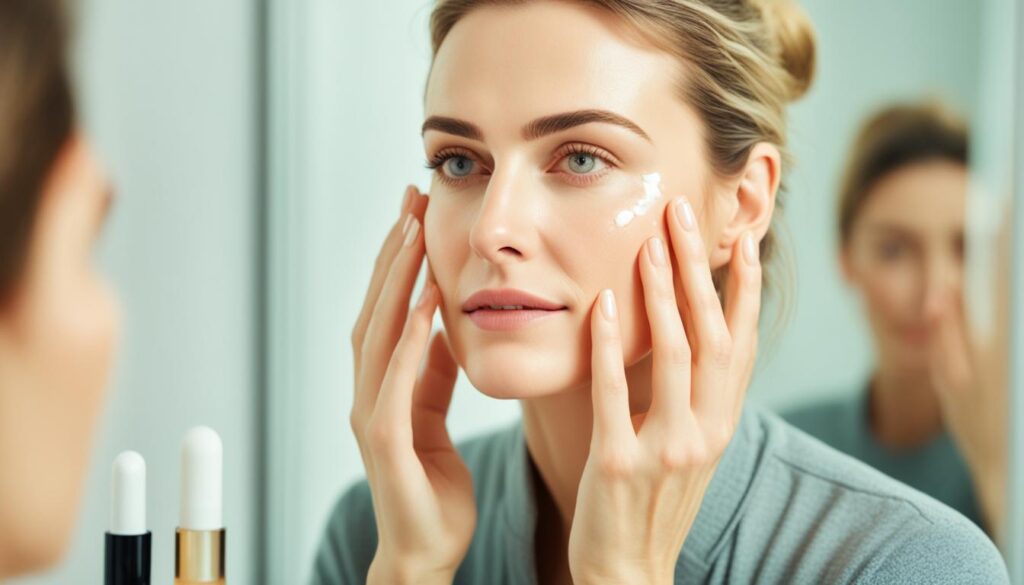
Exfoliation: How Often Should You Exfoliate?
Exfoliation is essential in any skincare routine, but finding the right balance for oily skin can be challenging. Understanding the frequency of exfoliation is crucial to effectively unclogging pores and removing dead skin cells without triggering excess oil production. Let’s explore this topic further to optimize your exfoliation routine for oily skin.
Exfoliating too frequently can strip away the skin’s natural oils, causing it to produce even more oil, leading to a greasy complexion. On the other hand, exfoliating too seldom can result in a buildup of dead skin cells, clogged pores, and dull-looking skin. It’s essential to strike a balance.
Exfoliating twice to thrice a week is recommended for people with oily skin. However, paying attention to your skin’s response and adjusting the frequency accordingly is essential. If your skin feels irritated or becomes overly dry after exfoliation, reduce the frequency to once a week. Conversely, if you notice that your skin remains oily and congested, you may benefit from exfoliating more often.
When selecting an exfoliant, choose gentle products with small granules or chemical exfoliants containing ingredients like salicylic or glycolic acid. These ingredients help to penetrate the pores, dissolve excess oil, and effectively remove dead skin cells. Avoid harsh scrubs or abrasive products, which can cause irritation and inflammation.
Remember to follow up on exfoliation with suitable skincare steps, such as toning and moisturizing, to restore the skin’s moisture balance and minimize potential oiliness. A consistent exfoliation routine can achieve a smoother and more radiant complexion.
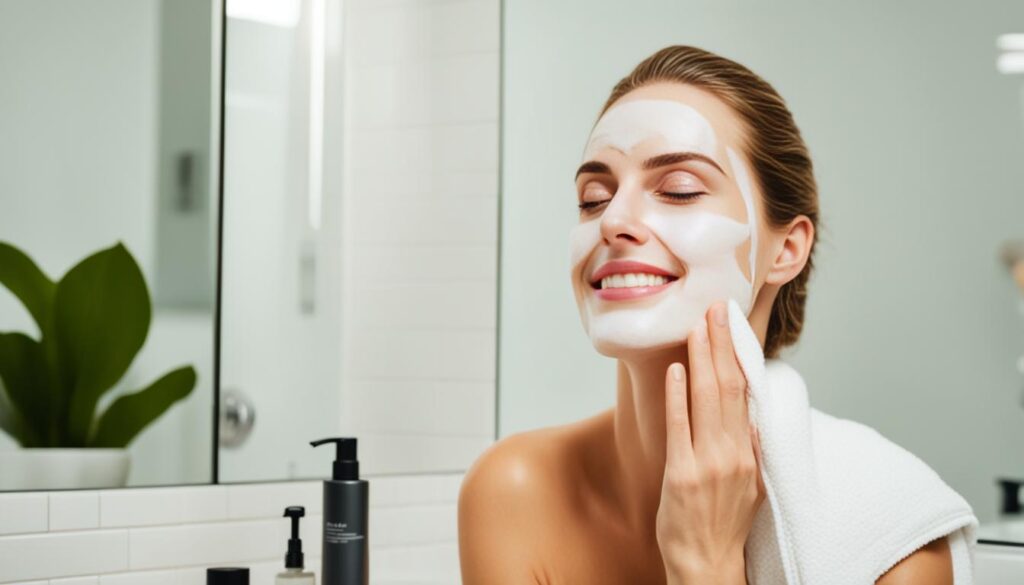
| Frequency: | Recommended for Oily Skin: | Signs to Adjust Frequency: |
|---|---|---|
| 2-3 times a week | It is effective for most individuals with oily skin | Irritation or excessive dryness |
| Once a week | If skin feels overly dry or irritated | Oily and congested skin |
Choosing the Best Products for Oily Skin
Selecting the right products is crucial for maintaining a balanced complexion when caring for oily skin. With many options available, finding the best ones that suit your skin’s needs can be overwhelming. In this section, we will explore the key ingredients to look for in oily skin products and provide guidance on navigating labels such as non-comedogenic, oil-free, and matte.
Ingredients to Look for in Oily Skin Products
When choosing skincare products for oily skin, paying attention to the ingredient list is essential. Certain ingredients can help regulate oil production, minimize pore size, and prevent breakouts.
- Salicylic Acid: A potent exfoliating ingredient that helps unclog pores and reduce oiliness.
- Niacinamide: This vitamin B3 derivative has oil-balancing properties and helps reduce the appearance of enlarged pores.
- Tea Tree Oil: Known for its antibacterial properties, it can help control acne-causing bacteria and reduce breakouts.
- Witch Hazel: A natural astringent that helps tighten the skin and reduce oil production.
- Mattifying Powders: Look for products that contain mattifying powders, such as silica or rice powder, which help absorb excess oil and give a matte finish.
These ingredients can be found in various skincare products, such as cleansers, toners, moisturizers, and serums specifically formulated for oily skin.
Navigating Labels: Non-comedogenic, Oil-free, and Matte
The labels found on skin care products can provide valuable information about their suitability for oily skin. Here’s what you need to know:
| Label | Description |
|---|---|
| Non-comedogenic | It indicates that the product is formulated not to clog pores, reducing the chances of acne breakouts. |
| Oil-free | This means the product contains no added oils, minimizing the likelihood of excess shine and greasiness. |
| Matte | Refers to products with a finish that absorbs excess oil, leaving a smooth, shine-free appearance. |
These labels can serve as a helpful guide when choosing products that won’t aggravate oiliness and acne-prone skin.
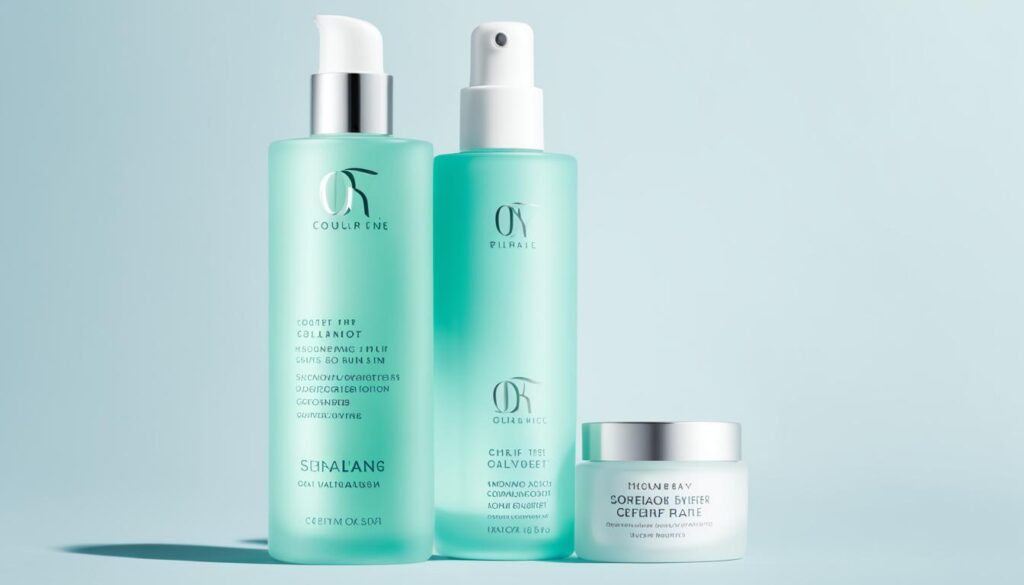
By understanding the ingredients to look for and deciphering product labels, you can confidently choose the best products for your oily skin. In the next section, let’s explore masks and treatments for oily skin.
Masks and Treatments Specifically for Oily Skin
Masks and treatments are essential to an effective skincare routine for oily skin. They can help control excess oil production, minimize pore size, and reduce acne breakouts. You can achieve a balanced and clearer complexion by incorporating targeted masks and treatments into your skincare regimen.
Regarding face masks for oily skin, opt for those formulated with oil-absorbing and pore-cleansing ingredients. Clay masks, such as bentonite or kaolin clay, are particularly beneficial for oily skin as they help draw out impurities and control shine. Charcoal masks are also effective in unclogging pores and absorbing excess sebum.
In addition to face masks, treatments specially designed for oily skin can provide targeted solutions. Some common treatments include:
- Salicylic acid treatment: Salicylic acid is a beta hydroxy acid that penetrates deep into the pores to help exfoliate dead skin cells and remove excess oil. It is effective in reducing acne breakouts and keeping the skin clear.
- Retinol treatment: Retinol, a form of vitamin A, can help regulate oil production, promote cell turnover, and improve the overall texture of the skin. It can also help minimize the appearance of acne scars and blemishes.
- Oil-controlling serums: Serums infused with niacinamide or tea tree oil can help control excess oil production and prevent clogged pores. They provide lightweight hydration without adding to the skin’s greasiness.
It is essential to follow the instructions provided with each mask or treatment and use them as recommended. Overusing or incorrectly using these products can lead to skin irritation and dryness. Incorporate masks and treatments into your skincare routine once or twice a week to achieve the best results.
Makeup and Oily Skin: Finding the Right Products
When it comes to makeup for oily skin, finding the right products is essential to achieving a long-lasting, matte finish. Oily skin can pose challenges, such as excessive shine and makeup breakdown throughout the day. However, with the correct primers, foundations, and application techniques, you can ensure your makeup stays in place and looks flawless.
Primers and Foundations Suited for Oily Skin
Using a primer specifically formulated for oily skin is crucial to combat oiliness and create a smooth canvas for makeup application. Look for primers that are oil-free and mattifying to help control shine. These primers help to absorb excess oil, minimize the appearance of pores, and extend the longevity of your makeup.
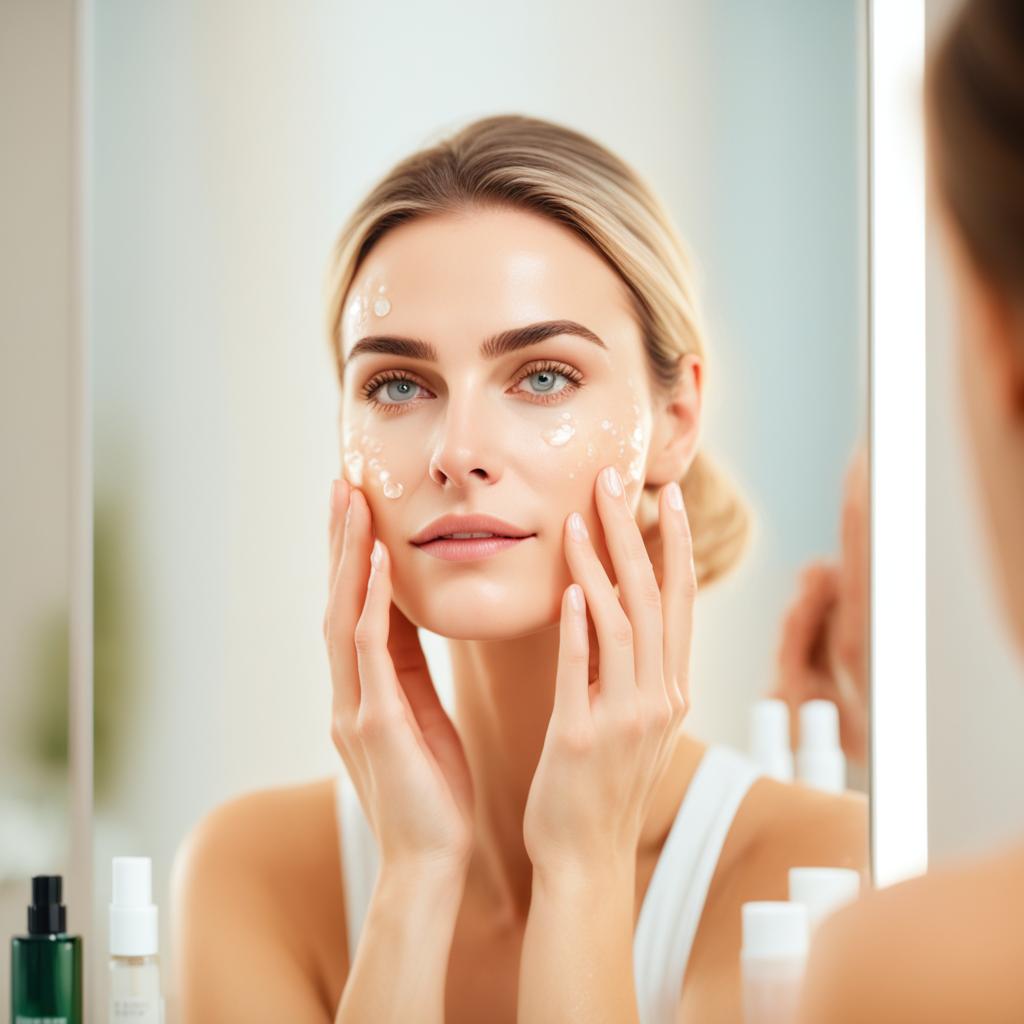
Foundations for oily skin should also be oil-free and non-comedogenic to prevent clogged pores and breakouts. Consider opting for matte or powder foundations that provide a shine-free finish. These foundations help control oil production and offer more long-lasting coverage.
Setting Your Makeup to Combat Oiliness
Setting your makeup is crucial for oily skin to combat oiliness and ensure it stays in place throughout the day. Use a setting powder to lock in your foundation and prevent shine. Apply the powder lightly and focus on the areas where oil accumulates, such as the T-zone.
Additionally, using a makeup setting spray can further enhance the longevity of your makeup. Look for setting sprays with oil-controlling properties that help to mattify the skin and keep your makeup fresh for hours.
You can achieve flawless and long-lasting makeup even with oily skin by choosing the proper primers and foundations and incorporating effective setting techniques.
Skincare Routines for Oily Skin
A consistent skincare routine is essential for managing oily skin and achieving a balanced complexion. This section will outline sample skincare routines explicitly tailored for oily skin. From morning to night, these routines will help you address excess shine, control oil production, and reduce the appearance of pores.
To start your day on the right foot, cleanse your face with a gentle cleanser formulated for oily skin. Look for products that contain ingredients like salicylic acid or tea tree oil to help control oil production and prevent breakouts.
Pro tip: Avoid using harsh exfoliants in your morning skincare routine, as they can strip away essential oils and lead to increased oil production.
After cleansing, follow up with an oil-free toner to balance your skin’s pH. Toners that contain ingredients like witch hazel or niacinamide can help reduce excess oil and tighten the appearance of pores.
Pro tip: You can apply your toner by gently patting it on your skin with clean hands or using a cotton pad.
Next, it’s time to moisturize. Opt for lightweight, oil-free moisturizers that provide hydration without adding extra shine. Look for products that are labeled as non-comedogenic, meaning they won’t clog your pores.
Pro tip: Applying a moisturizer with SPF during the day is crucial to protecting your skin from harmful UV rays.
Before bed, cleanse your face again to remove any makeup, dirt, or excess oil accumulated throughout the day. This double cleansing method can help ensure your pores are thoroughly clean.
After cleansing, consider incorporating a targeted treatment into your nighttime routine. Products containing ingredients like retinol or benzoyl peroxide can effectively reduce oiliness and prevent acne.
Pro tip: If you have sensitive skin, start with a low concentration of active ingredients and gradually increase it as your skin adapts.
Finally, apply a nourishing night cream or a lightweight gel moisturizer to give your skin the hydration it needs while you sleep.
Pro tip: If you’re dealing with stubborn breakouts or excessive oiliness, consider adding a weekly clay mask to your skincare routine. This can help draw out impurities and control oil production.
By following these simple skincare routines for oily skin, you can establish a daily routine that effectively tackles excess oil, promotes balanced skin, and enhances natural beauty.

Natural Remedies for Oily Skin
Natural remedies can be a great addition to your skincare routine. In addition to commercial products, homemade masks, and scrubs can provide effective solutions for oily skin. Using easily accessible ingredients, you can create DIY treatments that help control excess oil, reduce shine, and promote a healthier complexion.
Homemade Masks and Scrubs
Nature offers a wide range of beneficial ingredients for homemade masks and scrubs for oily skin. These natural remedies can help cleanse the pores, exfoliate dead skin cells, and balance oil production.
Skincare for oily skin can be challenging, with excess oil leading to clogged pores and breakouts. However, with fitting homemade masks and scrubs, you can effectively manage oily skin while avoiding the harmful chemicals in commercial products. Nature offers a wide range of ingredients that can benefit oily skin.
One natural remedy for oily skin is a homemade clay mask. Clay like bentonite or French green clay has incredible oil-absorbing properties. Applying a clay mask once or twice a week lets you draw out impurities from the skin and control oil production. Mix the clay with water or apple cider vinegar to create a thick paste, then apply it to your face and leave it on for about 15 minutes before rinsing off with warm water.
Another effective homemade remedy for oily skin is a coffee scrub. Coffee grounds are a gentle exfoliant, removing dead skin cells and unclogging pores. They also contain antioxidants that can help reduce inflammation. To make a coffee scrub, combine coffee grounds with a small amount of olive oil or honey to create a paste. Massage the scrub onto your damp face in circular motions, focusing on the areas where oil tends to accumulate. Rinse thoroughly and pat dry.
Caring for oily skin doesn’t involve expensive products or harsh ingredients. You can achieve a healthy, balanced complexion by turning to natural remedies. Remember to patch-test any new ingredient to ensure you don’t have any adverse reactions, and consult a dermatologist if you have persistent skin issues. You can conquer oily skin with consistent care and enjoy a radiant glow.

Here are a few homemade mask and scrub recipes:
- Green Tea Mask: Brew a cup of green tea and let it cool. Mix the tea with one tablespoon of honey and one tablespoon of yogurt. Apply the mixture to your face and leave it on for 15 minutes before rinsing it off.
- Lemon and Sugar Scrub: Combine half a lemon juice with two tablespoons of sugar. Gently massage the mixture onto your face in circular motions, focusing on oilier areas. Rinse off with warm water.
- Oatmeal and Honey Mask: Mix three tablespoons of ground oatmeal with one tablespoon of honey. Apply the mixture to your face and sit for 20 minutes before rinsing it off. Oatmeal helps absorb excess oil, while honey moisturizes and soothes the skin.
These homemade masks and scrubs can be used once or twice a week, depending on your skin’s needs. Remember to patch-test any new ingredients to avoid any potential allergic reactions.
The Role of Diet in Managing Oily Skin
In addition to external treatments, diet plays a crucial role in managing oily skin. Certain foods can either exacerbate or alleviate oil production and acne breakouts. You can support your skin’s balance and enhance its overall health by making healthy choices.
Here are some dietary tips for managing oily skin:
- Incorporate antioxidant-rich fruits and vegetables into your diet.
- Include foods high in omega-3 fatty acids, such as salmon and walnuts.
- Avoid consuming excessive amounts of refined sugar and processed foods.
- Stay hydrated by drinking an adequate amount of water throughout the day.
- Limit your intake of dairy products.
While diet alone may not eliminate oily skin, it can significantly contribute to its management when combined with a proper skincare routine.
| Foods to Include | Foods to Avoid |
|---|---|
| Fruits and vegetables high in antioxidants (e.g., berries, spinach) | Highly processed foods |
| Foods rich in omega-3 fatty acids (e.g., salmon, walnuts) | Fried and greasy foods |
| Whole grains | Excessive dairy consumption |
| Lean proteins (e.g., chicken, tofu) | Sugary snacks and drinks |
| Plenty of water | Alcohol and caffeine in excess |
Remember, a balanced and nutritious diet combined with appropriate skincare practices is critical to managing oily skin effectively.
Diet and Lifestyle: Impact on Oily Skin
Your diet and lifestyle choices can significantly impact the health of your skin. Certain foods can either aggravate or help balance sebum production in oily skin. This section will delve into the importance of a healthy diet and lifestyle for managing oily skin. We will also discuss the foods you should embrace and avoid to promote a balanced complexion.
Food to Embrace and Avoid for Oily Skin
While no specific foods directly cause or cure oily skin, making particular dietary choices can reduce excess sebum production and improve the overall health of your skin; here are some foods to embrace and avoid:
- Embrace: Incorporate fresh fruits and vegetables rich in antioxidants, such as berries, leafy greens, and citrus fruits, into your diet. These foods help combat inflammation and promote healthy skin.
- Avoid: Limit your consumption of processed and high-sugar foods, as they can increase sebum production. Additionally, reduce your intake of greasy and fried foods, which can exacerbate oily skin.
Remember, maintaining a well-balanced diet and avoiding excessive consumption of unhealthy foods can positively impact the health and appearance of your skin.
The Importance of Hydration and Sleep
Hydration and quality sleep are crucial in maintaining healthy skin, especially for those with oily skin. Here’s why:
- Hydration: Proper hydration is essential for all skin types, including oily skin. When you don’t drink enough water, your body may produce more oil to compensate for the lack of moisture. Ensure you drink adequate water daily to keep your skin hydrated and balanced.
- Sleep: Quality sleep, including your skin, allows your body to repair and regenerate. Lack of sleep can increase stress levels, triggering excess oil production. Aim for 7-8 hours of uninterrupted sleep each night to support overall skin health.
By prioritizing hydration and getting enough quality sleep, you can help manage the oiliness of your skin and achieve a healthy, glowing complexion.
When to See a Dermatologist About Your Oily Skin
While most oily skin concerns can be managed with a consistent skincare routine, there are instances where professional intervention may be necessary. If you are experiencing persistent or severe symptoms, it is essential to consult a dermatologist for expert guidance and treatments.
Recognizing Signs of Skin Issues
Recognizing the signs of skin issues is crucial in determining when to seek the help of a dermatologist. If you notice any of the following symptoms, it may be a sign that your oily skin requires professional attention:
- Persistent and severe acne breakouts
- Excessive oiliness that does not improve with skincare routine
- Enlarged and clogged pores
- Redness and irritation
- Flaky or peeling skin
- Unexplained changes in the texture or appearance of the skin
To accurately identify these signs, it is essential to closely monitor your skin’s behavior and seek the guidance of a dermatologist for proper diagnosis and treatment.
Professional Treatments for Severe Cases
If your oily skin concerns persist despite your best efforts with a skincare routine, a dermatologist can offer professional treatments tailored to your specific needs. Here are some common professional treatments for severe cases of oily skin:
| Treatment | Description |
|---|---|
| Laser therapy | It uses laser technology to target and reduce excessive oil production and acne-causing bacteria. |
| Chemical peels | It involves the application of a chemical solution to exfoliate the skin, improve texture, and minimize oiliness. |
| Microdermabrasion | It uses a minimally invasive procedure to gently exfoliate the skin and remove dead skin cells, reducing oiliness and improving overall skin texture. |
| Prescription medications | A dermatologist may prescribe oral or topical medications to manage excessive oil production, acne, or other underlying skin conditions. |
| Photodynamic therapy | It combines light and a photosensitizing agent to target and destroy oil glands, reducing oil production. |
Remember that these professional treatments should only be pursued under the guidance and supervision of a qualified dermatologist. They have the knowledge and expertise to assess your skin’s condition and recommend the most appropriate action.
How Hormones Affect Oily Skin and How to Adapt
Hormonal fluctuations can significantly impact the condition of your skin, especially if you have oily skin. The changes in hormone levels can increase oil production, resulting in an oily complexion and potentially triggering hormonal acne. Understanding how hormones affect your skin is crucial to adapting your skincare routine to manage the effects of these hormonal changes.
One of the essential hormones that influence oily skin and acne is testosterone. Both men and women produce testosterone, which is typically higher in males. Testosterone stimulates sebum production, the natural oil that lubricates and protects the skin. However, when there is an excess of testosterone or increased sensitivity, the sebaceous glands in the skin can produce too much oil, leading to oily skin and clogged pores.
Another hormone that plays a role in oily skin is estrogen. Estrogen helps regulate oil production and maintain a balanced and hydrated complexion. When estrogen levels fluctuate, such as during menstruation or menopause, oily skin can become more prone to breakouts and acne.
Adapting your skincare routine to manage hormonal changes is essential for maintaining healthy and clear skin. Here are some tips:
- Consistent cleansing: Cleanse your face twice daily with a gentle, non-comedogenic cleanser to remove excess oil and impurities without stripping the skin.
- Exfoliation: Incorporate exfoliation into your routine to remove dead skin cells and prevent clogged pores. However, be cautious not to over-exfoliate, as it can cause irritation and stimulate more oil production.
- Choose oil-free products: Look for skincare products labeled as oil-free or non-comedogenic. These formulations are designed to minimize clogged pores and reduce excess oil without compromising hydration.
- Spot treatments: Use targeted spot treatments with ingredients like salicylic acid or benzoyl peroxide to address acne breakouts caused by hormonal fluctuations.
Additionally, lifestyle changes such as managing stress levels, getting enough sleep, and maintaining a healthy diet can help regulate hormone levels and support overall skin health.
By understanding how hormones affect oily skin and adapting your skincare routine accordingly, you can effectively manage the effects of hormonal changes on your complexion. With the right approach, you can maintain a balanced and healthy-looking skin.
Advanced Beauty Techniques for Managing Oily Skin
This section will introduce advanced beauty techniques that can help manage oily skin. These innovative procedures and treatments target excess oil production and promote a balanced complexion. By incorporating these advanced techniques into your skincare routine, you can achieve lasting results and address the specific needs of oily skin.
One effective technique for managing oily skin is through oil-controlling treatments. These treatments utilize specialized products and procedures that regulate sebum production, reduce shine, and minimize the appearance of enlarged pores. They can help restore balance to your skin and create a smoother, more refined texture.
Additionally, there are innovative skincare procedures that specifically cater to oily skin. These procedures harness the power of advanced technologies to treat oil-related concerns such as acne, congestion, and uneven skin tone. These procedures promote healthier, clearer skin by targeting the root causes of oily skin.
When considering these advanced beauty techniques, it’s essential to consult with a professional skin care specialist or dermatologist. They can assess your skin’s needs and recommend the most suitable treatments for oily skin concerns.
By exploring these advanced techniques and working closely with skin care professionals, you can enhance your oily skin care routine and achieve your desired balanced, radiant complexion.
Conclusion
In conclusion, mastering a skincare routine tailored to oily skin is essential for achieving a balanced and radiant complexion. By implementing the beauty tips and techniques discussed throughout this article, you can effectively manage excess shine, minimize pores, and reduce breakouts associated with oily skin.
To begin, it is crucial to understand the challenges of oily skin and debunk common misconceptions. Identifying your skin type accurately will enable you to choose the most suitable skincare routine and products. A daily skincare routine should include cleansing, toning, and moisturizing, using products specifically designed for oily skin. Additionally, incorporating exfoliation at the right frequency can help unclog pores and remove dead skin cells without triggering excess oil production.
When choosing skincare products, look for key ingredients such as salicylic acid, witch hazel, and tea tree oil, which are known for their ability to control oil and prevent breakouts. Labels like non-comedogenic, oil-free, and matte can also guide you in selecting the best products for oily skin. In addition to a consistent skincare routine, consider using face masks and targeted treatments to effectively tackle specific oily skin concerns.
Lastly, don’t underestimate the impact of diet and lifestyle on oily skin. Embrace foods promoting a healthy complexion while avoiding those contributing to oiliness. Stay hydrated and prioritize quality sleep to support overall skin health. If you’re experiencing persistent skin issues, it may be wise to consult a dermatologist who can provide professional treatments for severe cases of oily skin.







